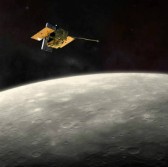 NASA’s Planetary Data System has unveiled Mercury’s initial global digital elevation model produced through the use of at least 100,000 images and data collected by the space agency’s MErcury Surface, Space ENvironment, GEochemistry and Ranging spacecraft.
NASA’s Planetary Data System has unveiled Mercury’s initial global digital elevation model produced through the use of at least 100,000 images and data collected by the space agency’s MErcury Surface, Space ENvironment, GEochemistry and Ranging spacecraft.
Johns Hopkins University Applied Physics Laboratory said Friday the global DEM details the planet’s lowest and highest elevation and other topographic features.
“[DEM] is the largest control network ever processed using the Integrated Software for Imagers and Spectrometers of the U.S. Geological Survey,†Kris Becker, Messenger team member and computer scientist at USGS.
PDS also released a map that shows a view of Mercury’s volcanic plains in the north pole, a global monochrome map and element concentration maps based on information collected by the space vehicle’s X-ray spectrometer.
PDS is a NASA science mission directorate-sponsored institution that archives and distributes data from NASA’s astronomical observations and other planetary missions.
The APL-built Messenger launched in 2004 and traveled for more than six years before it entered Mercury’s orbit in 2011.
The spacecraft crash-landed into Mercury’s surface on April 30, 2015 after over four years of orbiting the planet.




